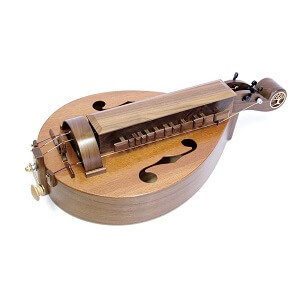Hurdy Gurdy
 Hurdy-gurdy, squat, pear-shaped fiddle having strings that are sounded not by a bow but by the rosined rim of a wooden wheel turned by a handle at the instrument’s end. Notes are made on the one or two melody strings by stopping them with short wooden keys pressed by the left-hand fingers. Up to four unstopped strings, called bourdons, sound drones.
Hurdy-gurdy, squat, pear-shaped fiddle having strings that are sounded not by a bow but by the rosined rim of a wooden wheel turned by a handle at the instrument’s end. Notes are made on the one or two melody strings by stopping them with short wooden keys pressed by the left-hand fingers. Up to four unstopped strings, called bourdons, sound drones.
The hurdy-gurdy was first mentioned in the 10th century as the organistrum. It was then a church instrument played by two men, one fingering the keys, one turning the wheel. Secular, one-man forms, called symphonia, appeared in the 13th century. It was fashionable during the reign of Louis XIV as the vielle à roue (“wheel fiddle”) and was played into the 20th century by folk and street musicians, notably in France and eastern Europe. The Swedish nyckelharpa is a similar fiddle with keys, but it is played with a bow.
Joseph Haydn composed a group of concerti and nocturnes for the lira organizatta, a variety of hurdy-gurdy having several small organ pipes attached to it. The name hurdy-gurdy sometimes mistakenly refers to other handle-operated street instruments, such as the barrel organ and barrel piano.